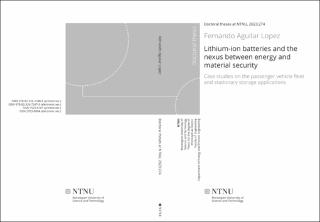| dc.contributor.advisor | Mueller, Daniel Beat | |
| dc.contributor.advisor | Strømman, Anders H. | |
| dc.contributor.author | Lopez, Fernando Aguilar | |
| dc.date.accessioned | 2023-09-15T09:28:15Z | |
| dc.date.available | 2023-09-15T09:28:15Z | |
| dc.date.issued | 2023 | |
| dc.identifier.isbn | 978-82-326-7247-9 | |
| dc.identifier.issn | 2703-8084 | |
| dc.identifier.uri | https://hdl.handle.net/11250/3089680 | |
| dc.description.abstract | Lithium-ion batteries (LIBs) are expected to play a key role in the decarbonization of the transport and energy sectors as they are considered to be a commercially available, low-emission energy storage technology. LIBs are needed to replace fuel in vehicles and to provide short-term storage to the electricity grid. However, the electrification of the more than 1.5 billion passenger vehicles on the road today in addition to the LIBs expected to be used for grid storage will require an unprecedented amount of raw materials. This increase has the potential to heavily influence global material cycles and disrupt supply chains. Such outcome would limit the production electric vehicles (EVs) and hinder the integration of renewable energy technologies in the electricity grid. Hence, the reliable access to energy to meet everyone’s basic needs and comfort (energy security), such as transport and electricity supply, depends to a large extent on the security of raw material supply for lithium-ion batteries. We term this reliable access to raw materials “material security” in analogy to energy security. Achieving energy and material security thus needs to be investigated from a nexus perspective, in which one cannot be attained without the other.
In this thesis, the demand for LIBs and their materials were investigated at Norwegian, European, and global levels for the passenger vehicle fleet and for grid services in the European case. Using dynamic material flow analysis, we modelled the effects of different parameters on material demand and investigated strategies to mitigate risks of supply chain bottlenecks by reducing demand. To do so, the product-component framework was developed to better understand the consequences of strategies such as reuse and replacement of components. Moreover, we evaluated the potential of vehicleto-grid, and second-life batteries to replace new stationary batteries for the grid, thereby increasing the resource efficiency of the overall LIB system. We used a novel inflowdriven, stock-constrained methodology that introduces dynamically informed parameters to link the transport and energy industries more intricately.
We showed that while technological changes can be expected to play an important role in the reducing resource use for LIBs, social and behavioral challenges will play similarly important roles. Using smaller EVs with smaller batteries; deciding to drive less if public transport or bicycles are an option; and connecting the EV frequently to participate in the vehicle-to-grid market can be important factors that have positive systemic consequences in reducing raw material demand. Furthermore, the reuse and replacement of batteries within vehicles can also play a pivotal role in reducing resource use. Legislation that focuses on the use of LIBs in EVs explicitly, instead of only targeting EV use, can lead to more efficient strategies to reduce resource use. We demonstrated that the replacement of electric vehicle batteries without reusing retired ones that are still functional can lead to the early obsolescence of the replacement battery and hence increase battery raw material demand. We further demonstrated that while reuse -either in vehicles or as second-life batteries - reduces primary material demand, it can be expected to lower the recycled content of batteries. Regulations around the recycled content of batteries favor recycling over reuse. Relying on this indicator for resource efficiency and sustainability can thus lead to counter-productive conclusions.
The risk of material supply chain disruptions can be mitigated either by increasing supply or by reducing demand. As the industry is increasingly put under stress to satisfy a rapidly increasing demand with a highly uncertain future development, managing the demand side is an ever more important lever society must take into consideration. Policies are often focused on regulating and incentivizing the supply-side of material systems, while neglecting the demand-side. In this thesis, we focus on demand-side intervention options for material and energy security by analyzing the stock dynamics of batteries in vehicles and grid systems. | en_US |
| dc.language.iso | eng | en_US |
| dc.publisher | NTNU | en_US |
| dc.relation.ispartofseries | Doctoral theses at NTNU;2023:274 | |
| dc.relation.haspart | Paper 1: Aguilar Lopez, Fernando; Billy, Romain Guillaume; Mueller, Daniel Beat. A product–component framework for modeling stock dynamics and its application for electric vehicles and lithium-ion batteries. Journal of Industrial Ecology 2022 ;Volum 26.(5) s. 1605-1615 https://doi.org/10.1111/jiec.13316 This is an open access article under the terms of the Creative Commons Attribution License (CC BY 4.0) | en_US |
| dc.relation.haspart | Paper 2: Aguilar Lopez, Fernando; Billy, Romain Guillaume; Mueller, Daniel Beat. Evaluating strategies for managing resource use in lithium-ion batteries for electric vehicles using the global MATILDA model. Resources, Conservation and Recycling 2023 ;Volum 193 https://doi.org/10.1016/j.resconrec.2023.106951 This is an open access article under the terms of the Creative Commons Attribution License (CC BY 4.0) | en_US |
| dc.relation.haspart | Paper 3:
Aguilar Lopez, F.; Lauinger, D.; Vuille, F.; Müller, D.B.
On the potential of vehicle-to-grid and second-life batteries to provide energy and material security for the EU | en_US |
| dc.relation.haspart | Paper 4: Thorne, Rebecca; Aguilar Lopez, Fernando; Figenbaum, Erik; Fridstrøm, Lasse; Mueller, Daniel Beat. Estimating stocks and flows of electric passenger vehicle batteries in the Norwegian fleet from 2011 to 2030. Journal of Industrial Ecology 2021 ;Volum 25.(6) s. 1529-1542 https://doi.org/10.1111/jiec.13186 This is an open access article under the terms of the Creative Commons Attribution License (CC BY 4.0) | en_US |
| dc.title | Lithium-ion batteries and the nexus between energy and material security: Case studies on the passenger vehicle fleet and stationary storage applications | en_US |
| dc.type | Doctoral thesis | en_US |
| dc.subject.nsi | VDP::Technology: 500::Environmental engineering: 610 | en_US |

